Regina Elisabeta a II-a, Nunta de diamant
|
Se spune despre monarhia din Marea Britanie ca este invechita. Pe situl ei internet, insa, navigheaza sute de mii de vizitatori, printre care mii de tineri, iar Nunta de Diamant, adica aniversarea a 60 de ani de la casatoria Reginei cu Ducele de Edinburg, beneficiaza de un “microsit” internet, separat.
De acolo poti afla, in timp real, despre evenimente, detalii ale anivarsarii, poti vedea fotografii, trimite mesaje si citi fapte despre cei 60 de ani de viata publica a celor doi suverani.
Regina Elisabeta si Ducele de Edinburg vor sarbatori cea de-a saizecea aniversare a casatoriei lor in ziua de 20 noiembrie. Slujba de la Westminster Abbey, la care am fost invitati Principesa Margareta si cu mine, are loc in dimineata de 19 noiembrie, la ora 11.30. Principesa Margareta a fost botezata in credinta ortodoxa de catre ASR Principele Filip, Duce de Edinburg. Botezul a avut loc la biserica ortodoxa din Lausanne. In continuarea slujbei, Majestatea Sa si Alteta Sa Regala vor dezveli un nou Panel Panoramic Jubiliar pe trotuarul din Piata Parlamentului. Colectia Regala a organizat o expozitie de opere de arta legate de casatoriile a cinci suverani ai Tronului Marii Britanii in ultimii 150 de ani. Expozitia este gazduita de Castelul Windsor.
Prin comparatie, in timp ce Marea Britanie a cunoscut, in acesti 60 de ani, un constant si neintrerupt sir de dezvoltari care o situeaza printre cele mai stabile, prospere si influente natiuni ale lumii, noua ne-au fost suficient 40 de ani ca sa distrugem aproape complet tesatura institutiilor statului, iar in ultimii 20-30 de ani sa afisam un comportament institutional care a trezit, in Europa si in lume, zambete, ingrijorari, neincredere, dispret si multe semne de intrebare. Este adevarat ca toate acestea nu s-au intamplat la voia soartei, ci cu nemijlocit “ajutor”. Poate ca cineva ar putea sa intrebe: ce legatura are o aniversare si nesemnificative detalii de ritual, de reprezentare cu dinamica secolului XXI, cu puterea si cu viata publica a tarilor lumii? Ei bine, raspunsul ar fi: faceti o plimbare prin centrul Bucurestiului si una prin centrul Londrei si veti intelege diferenta.
Exista, pe situl oficial al Monarhiei britanice, un material care prezinta 50 de fapte legate de domnia Reginei Elisabeta. Desi realizat cu cativa ani in urma, materialul este concludent: 50 FACTS ABOUT THE QUEEN’S REIGN 1. The Queen became the fifth longest serving monarch on 21 June 2002. Only five other kings and queens in British history have reigned for 50 years or more. These are: * Victoria (63 years) 2. Queen Elizabeth II is the fortieth monarch since William the Conqueror obtained the crown of England. 4. The Queen has personally held 459 Investitures. 5. The first Investiture of the Queen’s reign took place at Buckingham Palace on 27th February 1952. The first person to be presented was Private William Speakman, of The King’s Own Scottish Borderers, who received the Victoria Cross for his actions during the Korean War. 6. The Queen has received around 3 million items of correspondence. 7. Over the course of the reign, well over a million people have attended garden parties at Buckingham Palace or the Palace of Holyroodhouse (The Queen ended Presentation Parties in 1958). 8. Since 1952, The Queen has given Royal Assent to 3135 Acts of Parliament. 9. Over the reign, Her Majesty has given regular Tuesday evening audiences to 10 Prime Ministers. They are: * Winston Churchill 1951-55 11. The Queen is currently patron of 620 charities and organisations, 433 of which she has held since 1952. 12. In 50 years, The Queen has undertaken 251 official overseas visits to 128 different countries. 13. Many of The Queen’s official tours were undertaken on the Royal Yacht Britannia. It was launched by Her Majesty on April 16, 1953 and was commissioned for service on January 7, 1954. It was de-commissioned in December, 1997. During this time, Britannia travelled more than a million miles on Royal and official duties. 14. The Royal Yacht Britannia was first used by The Queen when she embarked with the Duke of Edinburgh on the 1st May 1954 at Tobruk for the final stage of their Commonwealth Tour returning to the Pool of London. The last time The Queen was on board Britannia for an official visit was on the 9th August 1997 for a visit to Arran. 15. By the end of 2002, The Queen will have visited Australia 14 times, Canada 20 times, Jamaica 6 times and New Zealand 10 times. 16. The Queen’s official visits have ranged from the Cocos Islands, 5.4 square miles with a population of 655, to The Peoples’ Republic of China, 3.7 million square miles with a population of 1.25 billion. 17. Unusual live gifts given to The Queen on foreign tours include: two tortoises given to The Queen in the Seychelles in 1972; a seven-year-old bull elephant called “Jumbo” given to Her Majesty by the President of Cameroon in 1972 to mark The Queen’s Silver Wedding, and a canary given to The Queen after the State visit to Germany in 1965. 18. The Queen has sent almost 100,000 telegrams to centenarians in the UK and the Commonwealth. 19. The Queen has sent more than 280,000 telegrams to couples in the UK and the Commonwealth celebrating their diamond wedding (60 years) anniversary. 20. The Queen’s real birthday is on April 21, but it is celebrated officially in June. 22. The Queen has given 84 State banquets during her reign to date. 23. The Queen has launched 17 ships during her reign. 24. The Queen and The Duke of Edinburgh have sent about 37,500 Christmas cards during The Queen’s reign. 25. The Queen has given out about 75,000 Christmas puddings to staff continuing the custom of King George V and King George VI. 26. The Queen learnt to drive in 1945. 27. The Queen was born at 17 Bruton St, London W1 on the 21st April, 1926, was christened on the 29th May, 1926 in the Private Chapel at Buckingham Palace and was confirmed on the 28th March, 1942 in the Private Chapel at Windsor Castle. 28. With the birth of Prince Andrew in 1960, The Queen became the first reigning Sovereign to have a child since Queen Victoria, who had her youngest child, Princess Beatrice, in 1857. 29. The Queen has 30 godchildren. 30. The first football match The Queen attended was the 1953 FA Cup Final. 31. The Queen has been at the saluting base of her troops in every Trooping the Colour ceremony since the start of her reign, with the exception of 1955, when a national rail strike forced the cancellation of the parade. 32. The Queen has sat for over 120 portraits during her reign. The most recent was painted in 2001 by Lucian Freud. 33. The first ‘Royal walkabout’ took place during the visit by The Queen and The Duke of Edinburgh to Australia and New Zealand in 1970. The practice was introduced to allow them to meet as many people as possible, not simply officials and dignitaries. 34. In 1969 the first television film about the family life of the Royal Family was made, and shown on the eve of the Investiture of Prince Charles as Prince of Wales. 35. An important innovation during The Queen’s reign was the opening in 1962 of a new gallery at Buckingham Palace to display items from the Royal Collection. The brainchild of The Duke of Edinburgh, the new Queen’s Gallery occupied the space of the Palace’s bomb-damaged private chapel. It was the first time that parts of the Palace had been opened to the general public. The new Queen’s Gallery is currently being redeveloped and will re-open in May, 2002 for the Golden Jubilee. 36. The only time The Queen has had to interrupt an overseas tour was in 1974 during a tour of Australia and Indonesia. The Queen was called back from Australia when a general election was called suddenly. The Duke of Edinburgh continued the programme in Australia, and The Queen re-joined the tour in Indonesia. 37. The Queen has opened Parliament every year except 1959 and 1963, when she was expecting Prince Andrew and Prince Edward respectively. 38. The Queen’s first Commonwealth tour began on 24 November 1953, and included visits to Canada, Bermuda, Jamaica, Panama, Fiji, Tonga, New Zealand, Australia, the Cocos Islands, Ceylon, Aden, Uganda, Libya, Malta and Gibraltar. The total distance covered was 43,618 miles. 39. The Queen has made a Christmas Broadcast to the Commonwealth every year of her reign except 1969, when a repeat of the film ‘Royal Family’ was shown and a written message from The Queen issued. 40. In 1953, The Queen made the first Christmas Broadcast from overseas, (rather than from the UK), broadcasting live from New Zealand. The first televised broadcast was in 1957, made live. The first prerecorded broadcast took place in 1960 to allow transmission around the world. 41. History was made in 1982 when Pope John Paul II visited Britain, the first Pope to do so for 450 years. The Queen, Titular Head of the Church of England, received him at Buckingham Palace. 42. The Queen has attended 46 Royal Maundy services in 35 cathedrals during her reign. A total of 5,100 people have received Maundy Money in recognition of their service to the Church and their communities. 43. During the Silver Jubilee year, The Queen toured thirty-six counties in the UK and Northern Ireland, starting in Glasgow on the 17th May. 44. The Queen’s first foreign tour of the Silver Jubilee year was a visit to Western Samoa, Tonga, Fiji, New Zealand, Australia and Papua New Guinea. The first foreign tour of The Queen’s Golden Jubilee year is to Jamaica, New Zealand and Australia. 45. The Queen has owned more than 30 corgis during her reign, starting with Susan who was a present for her 18th birthday in 1944. A good proportion of these have been direct descendants from Susan. Her Majesty currently has four corgis – Pharos, Swift, Emma and Linnet. 46. The Queen also introduced a new breed of dog known as the “dorgi” when one of Her Majesty’s corgis was mated with a dachshund named Pipkin which belonged to Princess Margaret. There have been 8 dorgis – Tinker, Pickles, Chipper, Piper, Harris, Brandy, Cider and Berry. 47. The Queen and The Duke of Edinburgh have been married for 54 years. They were married on November 20, 1947 in Westminster Abbey. The Queen’s wedding dress was designed by Norman Hartnell and was woven at Winterthur Silks Limited, Dunfermline, in the Canmore factory, using silk that had come from Chinese silkworms at Lullingstone Castle. 48. The Queen’s wedding ring was made from a nugget of Welsh gold which came from the Clogau St David’s mine near Dolgellau. The official wedding cake was made by McVitie and Price Ltd, using ingredients given as a wedding gift by Australian Girl Guides. 49. The Queen has laid her wreath at the Cenotaph on Remembrance Sunday every year of her reign, except in 1959, 1961, 1963, 1968, 1983 and 1999 when she was either pregnant or overseas on an official visit. 50. There have been five Archbishops of Canterbury during The Queen’s reign (Archbishops Geoffrey Fisher, Michael Ramsey, Donald Coggan, Robert Runcie and George Carey).
|

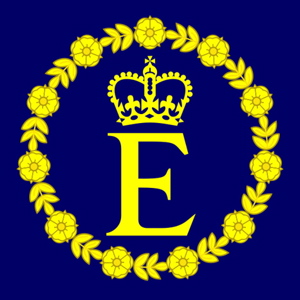
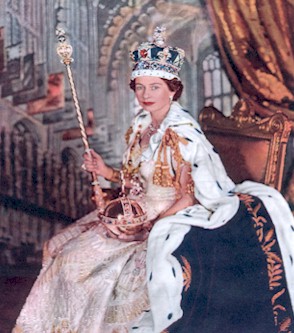
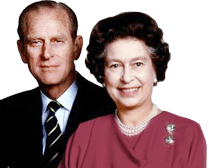
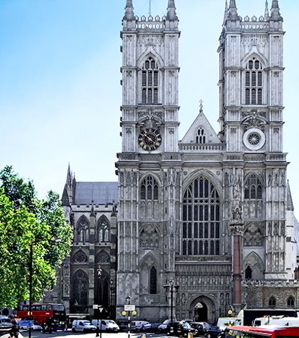
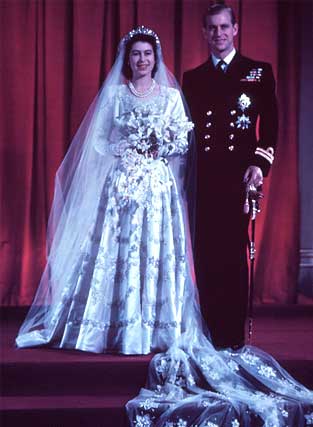
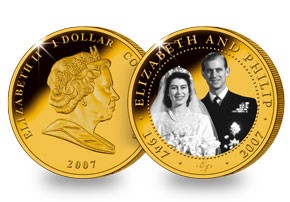
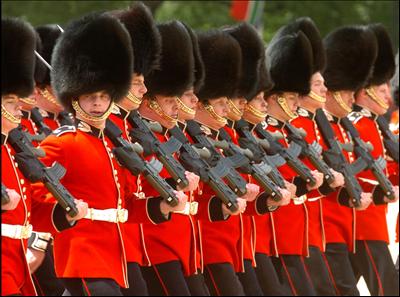
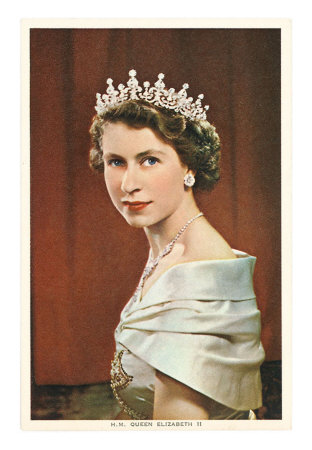
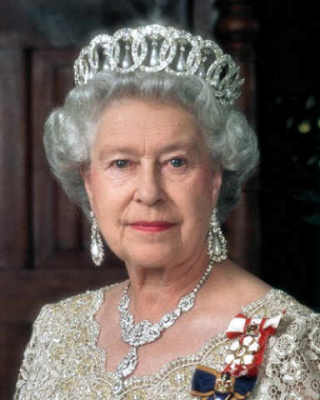
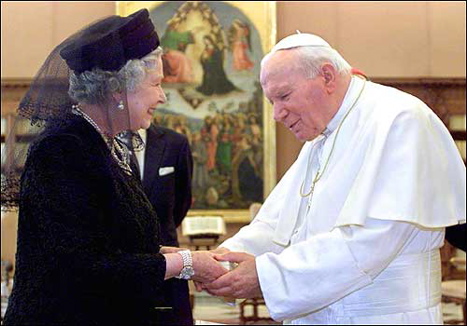
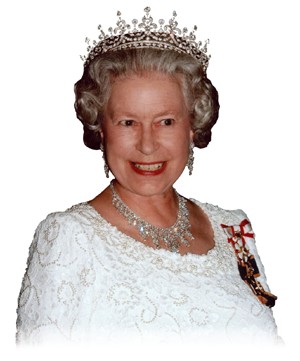
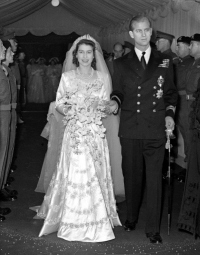




A list of 60 facts about The Queen and The Duke of Edinburgh to mark their Diamond Wedding Anniversary, published on 18 November 2007
1. The Queen is the first British monarch to have celebrated a Diamond Wedding Anniversary.
2. Princess Elizabeth and Prince Philip first met when they attended the wedding of Prince Philip’s cousin, Princess Marina of Greece to The Duke of Kent, who was an uncle of Princess Elizabeth, in 1934.
3. The engagement between Princess Elizabeth and Lieutenant Philip Mountbatten R.N was announced on the 9th July, 1947. Prince Philip was born Prince Philip of Greece and Denmark. He joined the Royal Navy in 1939 and after the war, in February 1947, became a naturalised British subject. Prince Philip was required to choose a surname in order to continue his career in the Royal Navy, and adopted Mountbatten, the name of his mother’s British relatives. He was created “Duke of Edinburgh” by King George VI on marriage.
4. The platinum and diamond engagement ring was made by the jewellers, Philip Antrobus Ltd, using diamonds from a tiara belonging to Prince Philip’s mother.
5. Prince Philip had two stag parties the night before the wedding – the first at the Dorchester to which the press were invited and the second with his closest friends at the Belfry Club.
6. The Queen and The Duke of Edinburgh were married in Westminister Abbey on the 20th November, 1947 at 11.30am with 2000 invited guests.
7. This was the first, and so far only time in British history, that the heir presumptive to the throne had been married.
8. The Queen was the 10th member of the Royal Family to be married in the Abbey. The first Royal wedding to take place in the Abbey was when King Henry I married Princess Matilda of Scotland on 11th November, 1100. On April 26th, 1923 The Queen’s parents King George VI and Queen Elizabeth (then The Duke and Duchess of York) were married there.
9. The eight bridesmaids were: HRH The Princess Margaret, HRH Princess Alexandra of Kent, Lady Caroline Montagu-Douglas-Scott, Lady Mary Cambridge, Lady Elizabeth Lambart, The Hon. Pamela Mountbatten, The Hon. Margaret Elphinstone, The Hon. Diana Bowes-Lyon.
10. There were two pages: HRH Prince William of Gloucester (aged 5) and HRH Prince Michael of Kent (aged 5).
11. Guests attending the wedding included the The King and Queen of Denmark, the King and Queen of Yugoslavia, the Kings of Norway, Romania and the Shah of Iran.
12. The Queen’s wedding dress was designed by Sir Norman Hartnell. Norman Hartnell submitted designs for the dress in August 1947.
13. The fabric for the dress was woven at Winterthur Silks Limited, Dunfermline, in the Canmore factory, using silk that had come from Chinese silkworms at Lullingstone Castle.
14. The Queen’s Bridal Veil was made of tulle and held by a tiara of diamonds.This tiara (which can also be worn as a necklace) was made for Queen Mary in 1919. It is made from re-used diamonds taken from a necklace/tiara purchased by Queen Victoria from Collingwood and Co and a wedding present for Queen Mary in 1893. In August, 1936, Queen Mary gave the tiara to Queen Elizabeth from whom it was borrowed by Princess Elizabeth for her wedding in 1947.
15. After the wedding, the dress was exhibited at St James’s Palace and was then shown in the capital towns of the British Isles and in Glasgow, Liverpool, Bristol, Preston, Leicester, Nottingham, Manchester, Bradford, Leeds and Huddersfield.
16. The bride’s wedding bouquet was supplied by the Worshipful Company of Gardeners and made by the Florist Mr MH Longman. It was of white orchids with a sprig of myrtle from the bush grown from the original myrtle in Queen Victoria’s wedding bouquet. An identical copy of the bouquet was made and presented to The Queen on her Golden Wedding in 1997.
17. The grave of the Unknown Warrior was the only stone that was not covered by the special carpet in the Abbey. The day after the wedding, Princess Elizabeth followed a Royal tradition started by her mother, of sending her wedding bouquet back to the Abbey to be laid on this grave.
18. The bridesmaids wore wreaths in their hair of minitaure white sheaves, Lilies and London Pride, modelled in white satin and silver lame. They were made by Jac Ltd of London. The pages wore Royal Stewart tartan kilts.
19. The bridesmaids’ bouquets, prepared by Moyses Stevens, were of white orchids, Lilies of the Valley, Gardinias, White Bouvardia, White Roses and White Nerine.
20. The bells of St Margaret’s Church, Westminster Abbey, hailed the arrival of the carriage procession. The Queen arrived at the Abbey with her father, George VI, in the Irish State Coach.
21. Other music at the wedding included: Psalm 67 (God be merciful unto us and bless us) sung to a setting by E.C.Bairstow; the motet “We wait for thy loving kindness, O God” by Dr William McKie, Organist and Master of the Choristers of the Abbey; the hymn “The Lord’s my shepherd” (to the then relatively unknown Scottish tune Crimond); the anthem “Blessed be the God and Father of our Lord Jesus Christ” by S.S.Wesley was sung by the Abbey choir and members of the choirs of the Chapel Royal and St George’s Chapel Windsor; and after signing the register in St Edward’s Chapel, the procession made its way out of the Abbey to Mendelssohn’s Wedding March.
22. There were 91 singers at the wedding, made up from the Abbey Choir, the Choir of HM Chapels Royal and additional tenors and basses. They sat in the organ loft as the choir stalls were occupied by various dignitaries.
23. William McKie, the Abbey organist, had been summoned to the Palace four days before the wedding so that Princesses Elizabeth and Margaret could sing the descant to “Crimond” to him so that he could note it down as no other copy was available.
24. The two Royal kneelers, used during the service, were covered in rose pink silk. They were made from orange boxes, due to war time austerity, and date stamped 1946.
25. The Altar was hung with the white dorsal given in 1911 by King George V and Queen Mary for their coronation and the 1937 coronation frontal given by the Princess’ parents. The Abbey plate was displayed on the altar.
26. The bride’s wedding ring was made from a nugget of Welsh gold which came from the Clogau St David’s mine near Dolgellau.
27. As not all the people to sign the register could fit into St Edward’s Chapel, only the bride and groom, the King and Queen, Queen Mary and Princess Andrew of Greece (the groom’s mother), the Archbishop, and the Dean of Westminster signed it at this point. The rest of the signatures (over two pages) were added later at Buckingham Palace. They included: Princess Margaret, Prince George of Greece (the groom’s uncle), Henry (Duke of Gloucester), Alice (Duchess of Gloucester), Princess Marina (Duchess of Kent), Lady Patricia Ramsay, Alexander Ramsay, Alice Mary (Countess of Athlone, Earl of Athlone, Victoria Milford Haven, Nada Milford Haven, Edwina Mountbatten of Burma, Earl Mountbatten of Burma, King Haakon (of Norway), King Michael (of Romania), Queen Ingrid (of Denmark), King Frederick (of Denmark).
28. Trumpet fanfares were introduced for the first time at a Royal wedding in the Abbey. A white flag was waved in the organ loft to signal the fanfare once the register had been signed.
29. The position of the BBC microphones had to be carefully checked as at the 1934 Royal wedding, the Abbey cross had hit the microphone suspended above the altar steps. Radio commentators shared the organ loft with the choir.
30. Thousands of people lined the processional route and were able to file through the Abbey after the service. Millions listened to the live radio broadcast.
31. The film of the wedding was watched by many thousands of people at cinemas across the country.
32. Around 10,000 telegrams of congratulations were received at Buckingham Palace.
33. The Royal couple received over 2,500 wedding presents from well-wishers around the world. Most were put on display for a few days in a charity exhibition at St James’s Palace. From India, there was a piece of crocheted, cotton lace made from yarn personally spun by Mahatma Ghandhi. The central motif reads “Jai Hind” (Victory for India).
34. Other gifts from abroad included a gold and jade necklace given by King Farouk of Egypt, a writing desk from the Government of New Zealand and pieces from a Chinese porcelain dinner service printed with characters denoting “double joy” given by President Chiang Kai Shek of the Chinese Republic.
35. As well as jewellery from their close relatives, including the King and Queen, the couple received many useful items for the kitchen and home, including salt cellars from the Queen, a bookcase from Queen Mary, and a picnic case from Princess Margaret.
36. Other gifts, kindly made and given by members of the public, included a hand-knitted cardigan, two pairs of bed socks, and a hand-knitted tea cosy.
37. Over 200,000 people visited the special exhibition of wedding presents at St James’s Palace.
38. The “wedding breakfast” (lunch) was held after the marriage ceremony at Westminster Abbey in the Ball Supper-room at Buckingham Palace. The menu was Filet de Sole Mountbatten, Perdreau en Casserole, Bombe Glacee Princess Elizabeth.
39. The bride and groom sat at the main table with the bride’s parents, King George VI and Queen Elizabeth, the bride’s grandmother, Queen Mary, her sister Princess Margaret, the groom’s mother, Princess Andrew of Greece, the groom’s uncle, Prince George of Greece and the Kings of Norway, Denmark and Romania.
40. Individual posies of myrtle and white Balmoral heather were placed at each place setting as “favours” (gifts to the guests).
41. The flowers decorating the tables were pink and white carnations, donated by the British Carnation Society.
42. The string band of the Grenadier Guards played music during the “wedding breakfast” under the direction of Captain F. J. Harris. The King’s Pipe Major also played at the lunch.
43. The official wedding cake was made by “McVities and Price”. Eleven other cakes were given as presents. With post-war food rationing still in place ingredients were sent as wedding presents from overseas, for example the official cake was made using ingredients given as a wedding gift by Australian Girl Guides. Pieces of cake and food parcels were later distributed to schoolchildren and institutions.
44. The cake was nine feet high in four tiers, with painted panels of the armorial bearings of both families, and included the monograms of bride and groom, sugar-iced figures to depict their favourite activities, and regimental and naval badges. The cake was cut using The Duke’s Mountbatten sword, which was a wedding present from the King.
45. United Biscuits, which now owns the former “McVities and Price” brand, will be making two cakes to mark the Diamond Wedding Anniversary in 2007. The first of the cakes will be on display at the lunch for members of various Royal Families at Buckingham Palace after the Service of Thanksgiving at Westminster Abbey on the 19th November. The second cake will be distributed to members of staff.
46. The bride and bridegroom left the Palace showered with rose petals. For the Princess’s going-away outfit, Hartell designed an ensemble of a dress and matching coat in mist-blue with mushroom-coloured assessories.
47. The couple departed Waterloo station with the Princess’s corgi, Susan, for their honeymoon.
48. The newlyweds spent their wedding night at Broadlands in Hampshire, home of Prince Philip’s uncle Earl Mountbatten. The second part of the honeymoon was spent at Birkhall on the Balmoral Estate.
49. Early in 1948 the couple leased their first marital home, Windlesham Moor, in Surrey, near Windsor Castle, where they stayed until they moved to Clarence House on 4th July 1949.
50. After marrying Princess Elizabeth, The Duke of Edinburgh continued his naval career, reaching the rank of Lieutenant-Commander in command of the frigate HMS MAGPIE.
51. Although he was The Queen’s husband, The Duke of Edinburgh was not crowned or anointed at the Coronation ceremony in 1953. He was the first subject to pay Homage to Her Majesty, and kiss the newly crowned Queen by stating “I, Philip, Duke of Edinburgh, do become your liege man of life and limb, and of earthly worship; and faith and truth I will bear unto you, to live and die, against all manner of folks. So help me God.”
52. Prince Philip has accompanied The Queen on all her Commonwealth tours and State visits, as well as on public engagements in all parts of the UK. The first of these was the Coronation tour of the Commonwealth from November 1953 to May 1954, when the couple visited Bermuda, Jamaica, Panama, Fiji, Tonga, New Zealand, Australia, Cocos Islands, Ceylon, Aden, Uganda, Libya, Malta and Gibraltar, travelling a distance of 43,618 miles.
53. The Duke of Edinburgh is only one of a few consorts to reigning female Queens in British history. William III was co-Sovereign with Mary II, although she, as daughter of James II, was nearer the throne than him. The husband of Queen Anne was not given the title of King, but remained Prince George of Denmark. Prince Albert was created Prince Consort by Queen Victoria in 1857.
54. The Queen and The Duke of Edinburgh have four children: Prince Charles, The Prince of Wales (b. 1948), Princess Anne, The Princess Royal (b. 1950), Prince Andrew, The Duke of York (b. 1960), and Prince Edward, The Earl of Wessex (b. 1964).
55. With the birth of Prince Andrew in 1960, The Queen became the first reigning Sovereign to give birth to a child since Queen Victoria, whose youngest child, Princess Beatrice, was born in 1857.
56. The Queen and The Duke of Edinburgh have seven grandchildren – Peter Phillips (b. 1977), Zara Phillips (b. 1981) Prince William (b. 1982), Prince Harry (b. 1984), Princess Beatrice (b. 1988), Princess Eugenie (b. 1990), and Lady Louise Windsor (b. 2003). The Earl and Countess of Wessex are expecting their second child in December.
57. The Queen and the Duke of Edinburgh celebrated their 6th wedding anniversary in the year of the coronation, with a dance at Clarence House given by Queen Elizabeth The Queen Mother. They left on their Commonwealth tour three days later.
58. The Queen and The Duke of Edinburgh have sat together for five painted portraits during their marriage, in 1949, 1956, 1962, 1966, and 1997.
59. A Service of Thanksgiving was held in Westminster Abbey for both the Silver and Golden wedding anniversaries.
60. There will be a Service of Thanksgiving in Westminster Abbey on the 19th November, 2007 to celebrate the Diamond Wedding Anniversary. On the 20th of November, the day of their wedding anniversary, The Queen and The Duke of Edinburgh will travel to Malta where they lived as a young married couple from 1949-51 while The Duke was stationed there as a serving Royal Naval officer.
populatia londrei e ce ma intereseaza